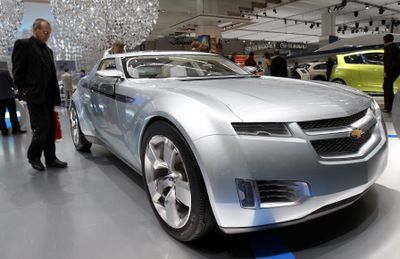GM says Volt is right on track
Rechargeable car set to debut in ’10

TRAVERSE CITY, Mich. — Early versions of the Chevrolet Volt’s battery packs are powerful enough to run the high-stakes rechargeable car, but dozens of issues remain before General Motors Corp. can start selling the revolutionary vehicle in 2010 as planned.
The Volt’s chief engineer is on a tight schedule to figure out how the car will handle the batteries’ weight, dissipate their heat and mechanically transfer their power to the wheels. That’s not to mention the list of issues that have nothing to do with the fact that the car plugs in to the wall for recharging.
But the 47-year-old veteran GM engineer who was recruited from a GM post in Germany to run the high-profile project is driven by knowing the entire company’s future could rest on it.
“At this point, there’s nothing standing in our way of continuing to do what we said we’re going to do,” Andrew Farah, the Volt’s chief engineer, said in a recent interview.
Work on the Volt, introduced as a concept car at the 2007 Detroit auto show, has taken on a more urgent pace with gasoline hovering near $4 per gallon and the U.S. auto market dramatically shifting from trucks to cars.
The car is designed to run on an electric motor powered by a battery pack. Drivers will recharge the vehicle from a standard home wall outlet.
The Volt will be able to travel 40 miles on a full charge, and a small gasoline engine will recharge the batteries to keep it rolling on longer trips. GM says the vehicle will get the equivalent of 150 miles per gallon.
But for now, as a new commercial airing during the Olympics touts the Volt as the pinnacle of GM’s fuel economy improvements and hybrid lineup, Farah and hundreds of other engineers are working quickly to deal with the inevitable glitches from new technology.
They must figure out how to keep the battery cool and adjust the car’s suspension so it performs well while carrying a 400-pound battery pack.
“All those things result in lots of other mechanical parts and bits and pieces that have nothing to do with electrical energy,” Farah said. “So we’ve had some issues there.”
Simultaneously, other GM workers are testing batteries to make sure they last at least 10 years or 150,000 miles. It would cost more than $10,000 to replace them.
Other workers are making the Volt more functional, giving it the room and feel of a regular car “such that the vehicle is not just a battery on wheels,” Farah said.
The early concept, a low-riding, sleek silver hatchback, was uncomfortable to sit in and not very functional, Farah said. The new five-door hatchback version more resembles a normal car, a little larger than a Honda Civic.
Although GM has promised to begin selling the Volt in a little more than two years, experts wonder if it will be ready in time, whether enough batteries will be available to sell the cars in significant numbers, and whether the cost can be reduced to make the car affordable to the masses. GM has said the Volt will cost $30,000 to $40,000, and that it expects to sell 100,000 per year starting in 2012.
While ambitious, that’s still 81,000 fewer than the number of Prius gas-electric hybrids sold by Toyota last year.
Brett Smith, assistant director for manufacturing and technology at the Center for Automotive Research, said even in small volumes, the Volt is a game-changer.
“It’s an entirely different technology. It’s an entirely different powertrain layout. It’s a huge step forward,” he said Tuesday at an industry conference in Traverse City.
Smith wonders, however, whether early buyers will wind up being part of an extended test.
“This and the other vehicles that are coming out in plug-in form … are in a lot of ways prototype vehicles being put on the market to test,” he said.
Toyota also is pushing to get its plug-in electric vehicle to market in 2010, while Ford Motor Co., which is testing 20 on roads in California, says it is five years away from producing them in significant numbers.
High gas prices already have forced lifestyle changes in the U.S., with people taking fewer vacations or weekend trips. Americans drove 53.2 billion fewer miles as gas prices climbed from November through June than they did over the same eight-month period a year earlier, the Federal Highway Administration said Wednesday.
The Volt, Farah said, can keep people mobile with only the adjustment of having to plug in a car at night.
“It’s an opportunity to change the way we consume energy without significantly changing our lifestyle,” he said.